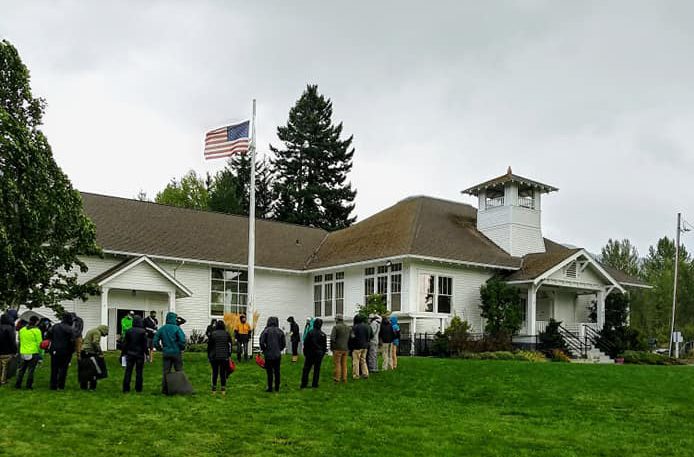
Technical Article
Case Study: Turning a Town Hall into a Microgrid
Mt. Hood Town Hall is a community gathering place in the Upper Hood River Valley that acts as a recycling center, community meals distribution hub, middle-school classroom, and a venue for special public events. Originally built in 1914 and owned by Hood River County, the facility is a registered Historic Building. In the past it has acted as a relief center during emergencies and has supported public health activities. Since 1988, the Mount Hood Towne Hall Association, through a long-term lease with the county, has restored the building and continues to operate it as the area's community center.
Due to its geography, Hood River County faces unique challenges to the resilience of its energy resources and infrastructure. Factors including wildfires, ice storms, earthquakes, high temperatures, and high winds are all potential causes of power outages for local residents and businesses. Much attention has been drawn to this by the 2018 Hood River County Energy Plan which identified energy resilience as a top priority. The Hood River County Energy Council (HRCEC), tasked with implementing the Hood River County Energy Plan, worked with the Hood River County Office of Emergency Management to identify Mt. Hood Town Hall as a critical facility that is ideally configured and located to serve as a resilience hub for the Upper Hood River Valley.
Fast forward to September 2023. With a specific site in mind and a list of resiliency goals in hand, Hood River County received a grant from the Oregon Department of Energy’s Community Renewable Energy Grant Program to fully fund a microgrid feasibility study for the proposed project.
Enter: Mayfield Renewables. Our team performed a load study, built resilience and financial models, assisted in equipment selection, and delivered a comprehensive feasibility study report and 30% preliminary plan set. Mayfield also shared its feasibility study findings at a public comment event organized by the project partners, adjusting the preliminary report based on feedback from the 40-50 community members in attendance.



a safe place to eat, play, and even get married.
Project Goals
The Hood River County Energy Council approached Mayfield Renewables after receiving feasibility study grant funding in January of 2024. The feasibility study focused on the Mt. Hood Town Hall building and the surrounding plot of land.
The community initially hoped the microgrid would provide two weeks of backup power, with a 50% confidence interval; however, when the project team decided not to include a fossil-powered generator in the design, the resilience capabilities were reexamined. Mayfield was tasked with offering a few specific visions of what was possible, then working with project partners and incorporating feedback from the local community to decide the best path forward.
More specifically, Mayfield produced several design options and modeled resilience performance for different load scenarios based on client load selection priorities. Feasibility studies commonly entail learning and active participation, and through that process, we clarified technical, functional, and aesthetic constraints.
Project Hurdles
Mayfield’s feasibility studies are iterative by necessity. Microgrid systems are complex. Our process is designed to identify previously unknown constraints, then we work with the client to find a workable solution.
The Mt. Hood Town Hall microgrid feasibility study provided a few examples of known and unknown constraints, which were evaluated with input from the Hood River County Energy Council, the Mount Hood Towne Hall Association Board of Directors, and community members to ensure the end result satisfied all parties.

Grant Funding
The feasibility study was fully funded by an Oregon Department of Energy grant. HRCEC intended to use the feasibility study to apply for a construction grant of up to $1 million, which acted as a firm budget constraint.
Mayfield designed the entire microgrid system around a $1 million budget for procurement and construction. The budget cap impacted decisions related to equipment selection, system size, system functionality, and aesthetics.
Load Selection
Load selection is a common hurdle in the development of microgrid systems when only a portion of loads can be backed up. In this case, due to wide seasonal variability in solar production, it was virtually impossible to provide two weeks of full backup power in the middle of winter with only PV and battery resources. Mayfield facilitated load selection with the project team.
During preliminary analysis, Mayfield modeled four load scenarios ranging from most inclusive (33 loads) to least (18 loads), and generated a synthetic load profile representing assumed electrical consumption patterns during each “scenario. The information was delivered in the dispatch chart shown above. The client ultimately selected the load scenario that they felt provided the optimal balance between facility operation and resilience performance during a grid outage.
Insufficient Load Data
Part of the load modeling process described above includes obtaining accurate load data. High-priority backup loads were distributed across multiple electrical panels. As a general best practice, Mayfield strongly recommends using interval data rather than representative load profiles.
Mayfield performed a load study by installing a metering device to collect interval data from one electric load panel in the facility that contained most of the loads the Town Hall wanted to back up, including a major heating unit. As luck would have it, the load study took place during a winter storm, which was one scenario the microgrid would be designed to handle.
Historic Building Designation
Built over a century ago, the Mt. Hood Town Hall is a registered Historic Building which puts it in a different (and far stricter) permitting category that aims to retain the building’s historical charm. That meant Mayfield could not default to maximizing the available roof space for a PV array. Instead, the entire system had to be designed to balance functionality and aesthetics.
Mayfield gathered site information from the Mount Hood Towne Hall Association (MHTHA) and conducted an in-person site visit to identify suitable locations for new microgrid equipment. Different PV canopy options (for example, a custom-built wood-framed solar canopy vs. pre-engineered steel purlins) were evaluated with MHTHA and the local AHJ to settle on an eye-pleasing yet permit-able design.


Results
The entire feasibility study took about four months to complete. Mayfield’s deliverables included a feasibility report with a system description, modeling inputs and assumptions, equipment specifications, and other important project details along with a 30% preliminary plan set.
Hood River County submitted the report and plan set as part of their construction grant application, which was later approved for the maximum amount of $967,000. Grant distributors are generally risk averse. Mt. Hood Town Hall project partners credit the information obtained from the thorough feasibility study report as one of the reasons for winning the competitive grant. As of this writing, construction is expected to begin in the fall of 2025.
Mayfield Renewables is an engineering consultancy specializing in commercial and industrial PV and microgrid engineering. Contact us today for a consultation.


